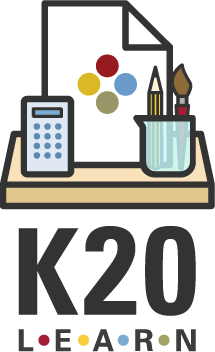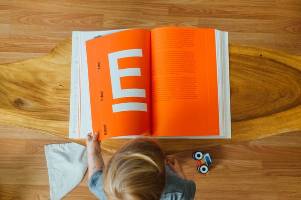Summary
In this lesson, students investigate the golden ratio by exploring the appeal of and interest in the golden rectangle. Students take a variety of measurements and use calculations to identify examples of the golden ratio and golden rectangle in many contexts throughout the lesson. Students identify the golden ratio in art then measure common objects and their own skeletal structure to determine where else the golden ratio is present.
Essential Question(s)
Are there common mathematical patterns around us?
Snapshot
Engage 1
Students examine similarities between paintings.
Explore 1
Students contemplate if there exists a rectangle that is most visually appealing and vote on a series of rectangles.
Explain 1
Students deepen their understanding of the golden ratio and golden rectangles.
Engage 2
Students discuss general size relationships in humans and which relationships may represent the golden ratio.
Explore 2
Students measure their bone lengths and record these measurements.
Explain 2
Students share approaches for estimating quotients, then use an approach to calculate ratios of their bone-length data.
Extend
Students identify common classroom objects that exhibit the golden ratio by taking objects’ measurements and calculating proportions.
Evaluate
Students summarize their learning by writing their own explanation of the golden ratio.
Materials
Lesson Slides (attached)
Journal Article document (attached)
Data Collection handout (attached; one per student)
Strategy Harvest handout (attached; one per student)
Ratio Calculations handout (attached; one per student)
Class Average spreadsheet (attached)
Pencil
Paper
Variety of measurement tools (e.g., rulers, meter sticks, tape measures, etc.)
Rectangular objects to be measured (e.g., playing cards, cereal boxes, plastic ID cards, business cards, shoe boxes, etc.)
Engage 1
5 Minute(s)
Introduce the lesson using the attached Lesson Slides. Transition through slide 3–4 to share the lesson’s essential question and learning objectives. Review these to the extent you deem necessary.
Move to slide 5, which shows DaVinci’s Mona Lisa and Lady with an Ermine. Ask students to share what they believe the images have in common. Use these paintings to capture curiosity and engage students. These paintings will be investigated further later in the lesson.
Explore 1
5 Minute(s)
Show slide 6 and conduct the "Rectangle Pageant.” Present students with the four rectangles on the slide (A, B, C, and D) and ask students to vote on the rectangle that they find most visually pleasing. Consider tallying student votes on the slide, either below or beside the corresponding rectangle.
Ask students if they think there is a universally correct answer for which rectangle is most visually pleasing. If necessary, rephrase the question to ask students if another class of students was shown the same slide and asked the same question, would they crown the same rectangle as the winner of the rectangle pageant? Lead a brief class discussion on the topic.
Share with students that psychologists often wonder if different people find the same things visually appealing, and mathematicians wonder if there is a mathematical reason behind things being visually appealing.
Tell students that rectangle B is an example of a golden rectangle, which is the rectangle that psychologists and mathematicians both reference in search of that connection. Let students know that they are going to learn more about the golden rectangle during the next phase of the lesson.
Explain 1
5 Minute(s)
Display slide 7 and share with students the definition of the golden ratio. Transition through slides 8–10 and elaborate on the golden ratio and the golden rectangle. Offer additional explanations as needed to help students understand the concept.
Show slide 11 and draw students’ attention to the paintings on the slide. These paintings are the same ones presented earlier in this lesson, but now with overlays of the golden rectangle to help students understand where people see the golden ratio in the images. Facilitate a brief discussion about the proportions of the paintings. Share with students that many people will often see what they are looking for, so if someone looks for the golden ratio or golden rectangle within a painting, they can choose different parts to compare in order to find that ratio. However, even if a person finds the golden ratio or golden rectangle, it does not mean that the original artist used the golden ratio to create the work.
Transition through slides 12–13 and let students know that the painting on the slides, Salvador Dali’s The Sacrament of the Last Supper, was purposefully designed using the golden ratio. We know this because he left behind written records that describe his intentions for the piece.
Engage 2
5 Minute(s)
Display slide 14 and lead a brief, whole-class discussion. Ask students, “Are you aware that the length of your foot is relatively the same length as your forearm?” You can demonstrate this by removing your shoe and holding it up against your forearm (the length of your arm between your elbow joint and wrist).
Follow that question by asking students, “Do you know of any other comparisons like this?” Invite them to share out any responses.
As students share, have them estimate their claims to check which claims are reasonable. For example, one can quickly confirm that the length of one’s index finger is not reasonably the same length as one’s ear.
Tell the class that the next activity involves testing some of these claims by measuring different body dimensions and finding different proportions.
Explore 2
20 Minute(s)
Have students find a partner who they will feel comfortable measuring and who will feel comfortable measuring them. Display slide 15 and give each pair one copy of the attached Data Collection handout. Tell students that they are expected to measure in centimeters. Have pairs select the measuring tools they think they need to accomplish the required measurements.
Show slide 16 and have pairs work together to measure the indicated body dimensions. Have them record those values in the table on their handouts.
Explain 2
40 Minute(s)
Display slide 17 and explain to students that calculators only do exactly what humans ask them to do. Share with students that if humans type the problem incorrectly, they will get a correct answer for the wrong problem. Facilitate a brief discussion with students about their experience with calculators. Ask students if they have ever accidentally typed the wrong thing into a calculator. Ask how they can know if the answer on the calculator screen is correct. Invite several students to share out. As they share, emphasize the importance of relying on number sense to determine if the answer is reasonable.
Move to slide 18 and give each student one copy of the attached Strategy Harvest handout. Read the following scenario on the slide, “A newborn baby is 20 inches long, and her legs are each 6 inches long. How could you estimate the ratio of the baby’s body length to leg length?” Ask students to consider how they would find that estimate then write their answer in the “My Strategy” portion of their handout. Give students approximately three minutes to complete this task.
Introduce the Strategy Harvest instructional strategy and display slide 19. Have students find a partner and share the strategies they invented for estimating the ratio. Tell students to record their partner’s strategy and name in the “Partner 1’s Strategy” portion of the handout. Have students actively listen and encourage them to participate in a discussion by asking questions and offering feedback about their partner’s strategy. Allow approximately three minutes to complete this activity.
Have students repeat this process two more times. Each time they should find a new partner and record their partner’s strategy in the next space on their handout. After students complete their handouts, bring the whole class together and invite volunteers to share out one of their partner’s strategies.
Give each pair one copy of the attached Ratio Calculations handout and a calculator. Display slide 20 and have students use the measurements on their Data Collection handouts to find the ratios on their Ratio Calculations handouts. Have students record their values as fractions (for easy reference of which two numbers they used) and as a decimal approximation. Have students round their decimals to three decimal places.
Once students have sufficient understanding of the task and have completed at least half of their tables, transition to slide 21. Notify students that they should refer to this slide when they are ready to find the average ratio in the final row of their tables.
Show slide 22 and have one member from each team report the averages for each student. As they share out, collect this data for the whole class in the attached Class Average spreadsheet.
Initiate a whole-class discussion about students’ findings. Ask the class to determine who the “Golden Genius” is, which would be the student whose ratio is closest to the golden ratio.
Extend
20 Minute(s)
Show slide 23 and have students rejoin their original partners. Have them work together to measure and identify at least three rectangular objects in the room that they think exhibit the golden ratio. Notify students that the rectangular objects do not have to be movable, and may include cabinets, tiles, windows, doors, or any other object they believe exhibits the golden ratio.
Have students record their chosen objects and their measurements on a piece of notebook paper, along with an explanation of whether or not the objects exhibited the golden ratio.
Once students are done measuring and calculating their proportions, bring the class together and have students share out which objects they classified as golden rectangles.
Evaluate
5 Minute(s)
Display slide 24 and introduce the Two-Minute Paper instructional strategy. Ask students to respond to the question on the slide. Have them explain the golden ratio to someone not in their class and have them provide an example of the ratio. Start the 2-minute timer on the slide.
Resources
Dalí, S. (1955). The sacrament of the Last Supper [Painting]. National Gallery of Art, Washington D.C., United States. https://www.nga.gov/collection/art-object-page.46590.html
Da Vinci, L. (1490). Lady with an ermine [Painting]. Czartoryski Museum, Kraków, Poland. https://commons.wikimedia.org/wiki/File:The_Lady_with_an_Ermine.jpg
Da Vinci, L. (1506). Mona Lisa [Painting]. Musée du Louvre, Paris, France. https://commons.wikimedia.org/wiki/File:France-003324_-_Mona_Lisa_(16236519171).jpg
K20 Center. (n.d.). GeoGebra. Tech Tools. https://learn.k20center.ou.edu/tech-tool/2352
K20 Center. (n.d.). Google sheets. Tech Tools. https://learn.k20center.ou.edu/tech-tool/2855
K20 Center. (n.d.). Strategy harvest. Strategies. https://learn.k20center.ou.edu/strategy/135
K20 Center. (n.d.). Two-minute paper. Strategies. https://learn.k20center.ou.edu/strategy/152
K20 Center. (2021, September 21). K20 Center 2 minute timer [Video]. YouTube. https://youtu.be/HcEEAnwOt2c?si=IjQ0Z14eT1CEtWwS
Reeder, S. (2007, October). Are we golden?. Mathematics Teaching in the Middle School, 3(13), 150–155. http://www.shastacoe.org/uploaded/scmp2/are_we_golden_copy_x.pdf




